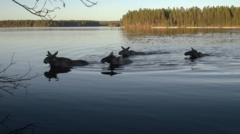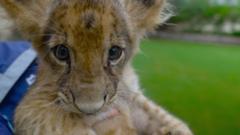The Great Moose Migration in Sweden has turned into a "slow TV" phenomenon watched by millions, bringing relaxation and connection to nature for fans during its annual livestream.
The Charm of Sweden's Elk Migration: Millions Tune In to Nature's Journey

The Charm of Sweden's Elk Migration: Millions Tune In to Nature's Journey
Sweden's annual elk migration captivates millions with live coverage of their journey across the Angerman River while offering a tranquil escape for viewers.
Every spring, millions around the globe eagerly tune in to experience "The Great Moose Migration," a captivating program aired by SVT Play, the streaming service linked to Sweden's national broadcaster. This year, viewers had the pleasure of catching the first glimpse of the elk’s travel a week earlier than usual due to unseasonably warm weather for April. The livestream, which began just this Tuesday, has gained traction for its immersive experience since its debut in 2019.
Cait Borjesson, a devoted follower of the migration who started watching during the pandemic, expressed how watching the moose has transformed into a peaceful yearly ritual. "It's unbelievably relaxing," she noted, detailing how the natural sounds and sights create a therapeutic experience amidst her routine. Cait goes as far as to take time off from work to indulge in the three-week-long broadcast, echoing sentiments shared by numerous viewers in a Facebook group where over 77,000 members engage in sharing their emotional responses and memorable experiences related to the migration.
The journey of these majestic animals, referred to as moose in North America and elk in Europe, is heavily documented as they cross through the village of Kullberg alongside the Angerman River. Goran Ericsson, a forest science dean from the Swedish University of Agricultural Sciences involved in the live coverage, explained that this migration has deep historical roots dating back to the ice age. He highlighted that 95% of Sweden's northern elk partake in this seasonal trek to find greener pasture as winter habitats come to an end. "Earlier migrations have been observed before, and this year can be attributed to less snowfall on the ground," he clarified, reminding everyone that while early springs are not common, they still fall into seasonal variation.
The production utilizes over 30 cameras to follow the elk's progress through Sweden’s expansive terrain. The phenomenon draws tremendous interest, beginning with nearly a million viewers at its launch and growing to nine million in 2024. Minh-Xuan Truong, a researcher from the Swedish University of Agricultural Sciences, noted that amid the fast-paced world of media consumption, audiences gravitate towards the slow, unedited nature of this programming. He emphasized that many viewers appreciate the authentic sounds of wildlife over background music or commentary, reflecting a growing desire to reconnect with nature amidst modern life's chaos.
Sweden’s elk population, known as "Kings of the Forest," comprises about 300,000 individuals, a mark of the rich biodiversity found within the country’s woodlands. This yearly migration captures not just the essence of wildlife but serves as a reminder of the tranquil beauty of the natural world, drawing people together across borders in appreciation of nature's wonders.


















